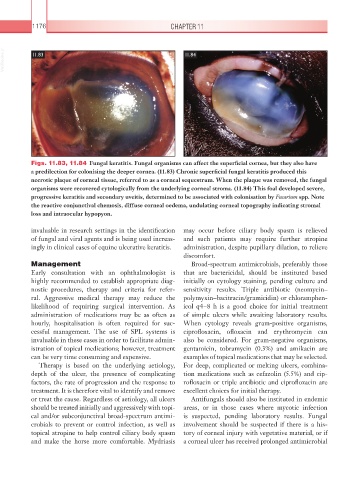Page 1201 - Equine Clinical Medicine, Surgery and Reproduction, 2nd Edition
P. 1201
1176 CHAPTER 11
VetBooks.ir 11.83 11.84
Figs. 11.83, 11.84 Fungal keratitis. Fungal organisms can affect the superficial cornea, but they also have
a predilection for colonising the deeper cornea. (11.83) Chronic superficial fungal keratitis produced this
necrotic plaque of corneal tissue, referred to as a corneal sequestrum. When the plaque was removed, the fungal
organisms were recovered cytologically from the underlying corneal stroma. (11.84) This foal developed severe,
progressive keratitis and secondary uveitis, determined to be associated with colonisation by Fusarium spp. Note
the reactive conjunctival chemosis, diffuse corneal oedema, undulating corneal topography indicating stromal
loss and intraocular hypopyon.
invaluable in research settings in the identification may occur before ciliary body spasm is relieved
of fungal and viral agents and is being used increas- and such patients may require further atropine
ingly in clinical cases of equine ulcerative keratitis. administration, despite pupillary dilation, to relieve
discomfort.
Management Broad-spectrum antimicrobials, preferably those
Early consultation with an ophthalmologist is that are bactericidal, should be instituted based
highly recommended to establish appropriate diag- initially on cytology staining, pending culture and
nostic procedures, therapy and criteria for refer- sensitivity results. Triple antibiotic (neomycin–
ral. Aggressive medical therapy may reduce the polymyxin–bacitracin/gramicidin) or chloramphen-
likelihood of requiring surgical intervention. As icol q4–8 h is a good choice for initial treatment
administration of medications may be as often as of simple ulcers while awaiting laboratory results.
hourly, hospitalisation is often required for suc- When cytology reveals gram-positive organisms,
cessful management. The use of SPL systems is ciprofloxacin, ofloxacin and erythromycin can
invaluable in these cases in order to facilitate admin- also be considered. For gram-negative organisms,
istration of topical medications; however, treatment gentamicin, tobramycin (0.3%) and amikacin are
can be very time consuming and expensive. examples of topical medications that may be selected.
Therapy is based on the underlying aetiology, For deep, complicated or melting ulcers, combina-
depth of the ulcer, the presence of complicating tion medications such as cefazolin (5.5%) and cip-
factors, the rate of progression and the response to rofloxacin or triple antibiotic and ciprofloxacin are
treatment. It is therefore vital to identify and remove excellent choices for initial therapy.
or treat the cause. Regardless of aetiology, all ulcers Antifungals should also be instituted in endemic
should be treated initially and aggressively with topi- areas, or in those cases where mycotic infection
cal and/or subconjunctival broad-spectrum antimi- is suspected, pending laboratory results. Fungal
crobials to prevent or control infection, as well as involvement should be suspected if there is a his-
topical atropine to help control ciliary body spasm tory of corneal injury with vegetative material, or if
and make the horse more comfortable. Mydriasis a corneal ulcer has received prolonged antimicrobial

